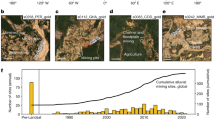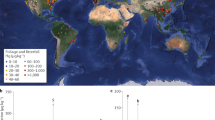Abstract
CONCENTRATIONS of mercury in the environment are increasing as a result of human activities, notably fossil-fuel burning and incineration of municipal wastes. Increasing levels of mercury in aquatic environments and consequently in fish populations are recognized as a public-health problem1,2. Enhanced mercury concentrations in lake sediments relative to pre-industrial values have also been attributed to anthropogenic pollution. It is generally assumed that atmospheric mercury deposition is dominated by global-scale processes, consequently being regionally uniform. Here, to the contrary, we report a significant gradient in concentrations and total amounts of mercury in organic litter and surface mineral soil along a transect of forested sites across the north central United States from northwestern Minnesota to eastern Michigan. This gradient is accompanied by parallel changes in wet sulphate deposition and human activity along the transect, suggesting that the regional variation in mercury content is due to deposition of anthropogenic mercury, most probably in particulate form.
This is a preview of subscription content, access via your institution
Access options
Subscribe to this journal
Receive 51 print issues and online access
$199.00 per year
only $3.90 per issue
Buy this article
- Purchase on Springer Link
- Instant access to full article PDF
Prices may be subject to local taxes which are calculated during checkout
Similar content being viewed by others
References
Minnesota Fish Consumption Advisory, Minnesota Department of Health (Minneapolis, 1989).
Health Advisory PUBL-1E-019 (89REV), Wisconsin Department of Natural Resources (Madison, 1988).
Fitzgerald, W. F. in The Role of Air-Sea Exchange in Geochemical Cycling (ed, Buat-Ménard, P.) 363 (Reidel, Boston, 1986).
Slemr, F., Seiler, W. & Schuster, G. J. geophys. Res. 86, 1159–1166 (1981).
Fitzgerald, W. F., Mason, R. P. & Vandal, G. M. Water Air Soil Pollut. 56, 745–767 (1991).
Xiao, Z. F., Munthe, J. & Lindqvist, O. Water Air Soil Pollut. 56, 141–151 (1991).
Brosset, C. Water Air Soil Pollut. 17, 37 (1982).
Buat-Ménard, P. & Duce, R. A. in Lead, Mercury, Cadmium, and Arsenic in the Environment (eds Hutchinson, T. C. & Meema, K. M.) (Wiley, New York, 1987).
Evans, R. D. Arch. Envir. Contam. Toxicol. 15, 505–512 (1986).
Mierle, G. Envir. Toxicol. Chem. 9, 843–851 (1990).
Aastrup, M., Johnson, J., Bringmark, E., Bringmark, I. & Iverfeldt, Å. Water Air Soil Pollut. 56, 155–167 (1991).
Andersson, A. in The Biogeochemistry of Mercury in the Environment (ed. Nriagu, J. O.) 79–109 (Elsevier/North-Holland, New York, 1979).
Verry, E. S. & Harris, A. R. Water Resourc. Res. 24, 481–492 (1988).
Harris, A. R. & Verry, E. S. in Hydrological and Hydrogeochemical Mechanisms and Model Approaches to the Acidification of Ecological Systems, Proc. Int. Hydrological Progr. Workshop (ed. Johansson, I.) 57–65 (Coordinatory Committee for Hydrology, Oslo, 1985).
Grigal, D. F. & Ohmann, L. F. J. envir. Qual. 18, 368–373 (1989).
Ohmann, L. F. & Grigal, D. F. USDA Forest Services Res. Bull. NC-130 (1991).
Nater, E. A. & Grigal, D. F. Report to the Minnesota Pollution Control Agency St Paul. Minnesota (1992).
Snedecor, G. W. & Cochran, W. G. Statistical Methods, 6th Edn (Iowa State Univ. Press, 1967).
Smith, C. W. Agron. J. 70, 123–127 (1978).
Wilkinson, L. SYSTAT: The System for Statistics (SYSTAT Inc., Evanston, 1986).
Ohmann, L. F., Grigal, D. F. & Brovold, S. USDA Forest Service Res. Bull. RB-NC-110 (1989).
Brigham, M. thesis, Univ. of Minnesota (1991).
David, M. B., Grigal, D. F., Ohmann, L. F. & Gertner, G. Z. Can. J. Forest Res. 18, 1386–1391 (1988).
Ohmann, L. F. & Grigal, D. F. Can. J. Forest Res. 20, 508–513 (1990).
Lindberg, S. E., Turner, R. R., Meyers, T. P., Taylor, G. E. Jr & Schroeder, W. H. Water Air Soil Pollut. 56, 577–594 (1991).
Iverfeldt, Å. Water Air Soil Pollut. 56, 251–265 (1991).
Steinnes, E. & Andersson, E. M. Water Air Soil Pollut. 56, 391–404 (1991).
Johansson, K., Aastrup, M., Andersson, A., Bringmark, L. & Iverfeldt, Å. Water Air Soil Pollut. 56, 267–281 (1991).
Lathrop, R. C. Rasmussen, P. W. & Knauer, D. R. Water Air Soil Pollut. 56, 295–307 (1991).
Author information
Authors and Affiliations
Rights and permissions
About this article
Cite this article
Nater, E., Grigal, D. Regional trends in mercury distribution across the Great Lakes states, north central USA. Nature 358, 139–141 (1992). https://doi.org/10.1038/358139a0
Received:
Accepted:
Issue Date:
DOI: https://doi.org/10.1038/358139a0
This article is cited by
-
Watershed influences on mercury in tributaries to Lake Ontario
Ecotoxicology (2020)
-
Impacts of Invasive Earthworms on Soil Mercury Cycling: Two Mass Balance Approaches to an Earthworm Invasion in a Northern Minnesota Forest
Water, Air, & Soil Pollution (2016)
-
Wet deposition flux and runoff output flux of mercury in a typical small agricultural watershed in Three Gorges Reservoir areas
Environmental Science and Pollution Research (2015)
-
An Assessment of Mercury Contamination and the Relationship Between Environmental Variables and Mercury Concentrations in a Seasonal Wetland
Water, Air, & Soil Pollution (2013)
-
Spring Snowmelt and Mercury Export from a Forested Catchment in the Czech Republic, Central Europe
Bulletin of Environmental Contamination and Toxicology (2011)
Comments
By submitting a comment you agree to abide by our Terms and Community Guidelines. If you find something abusive or that does not comply with our terms or guidelines please flag it as inappropriate.



